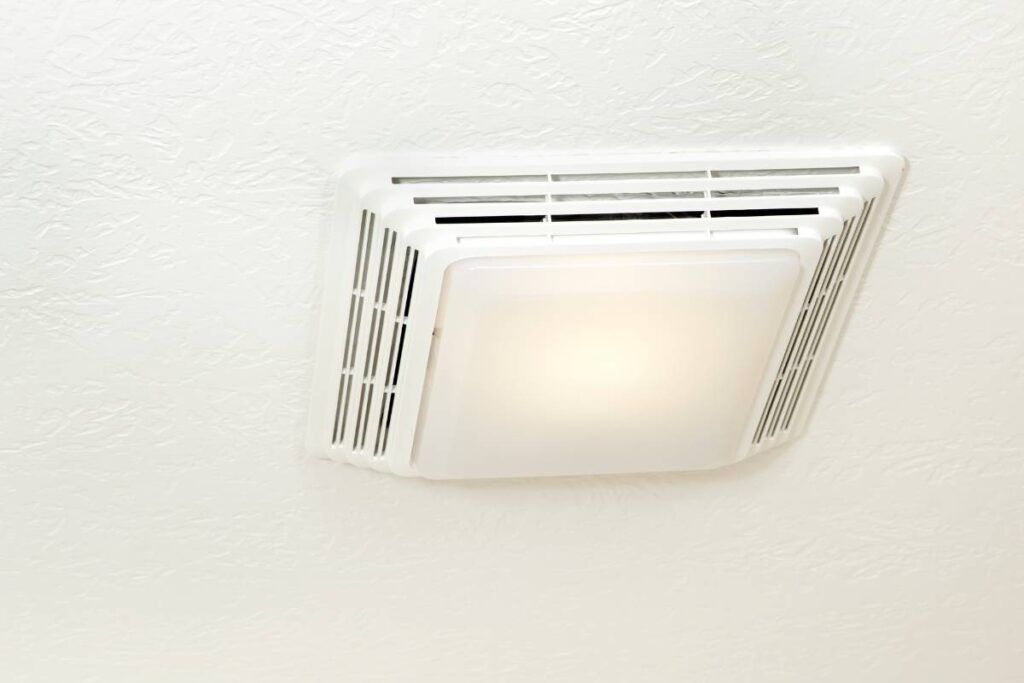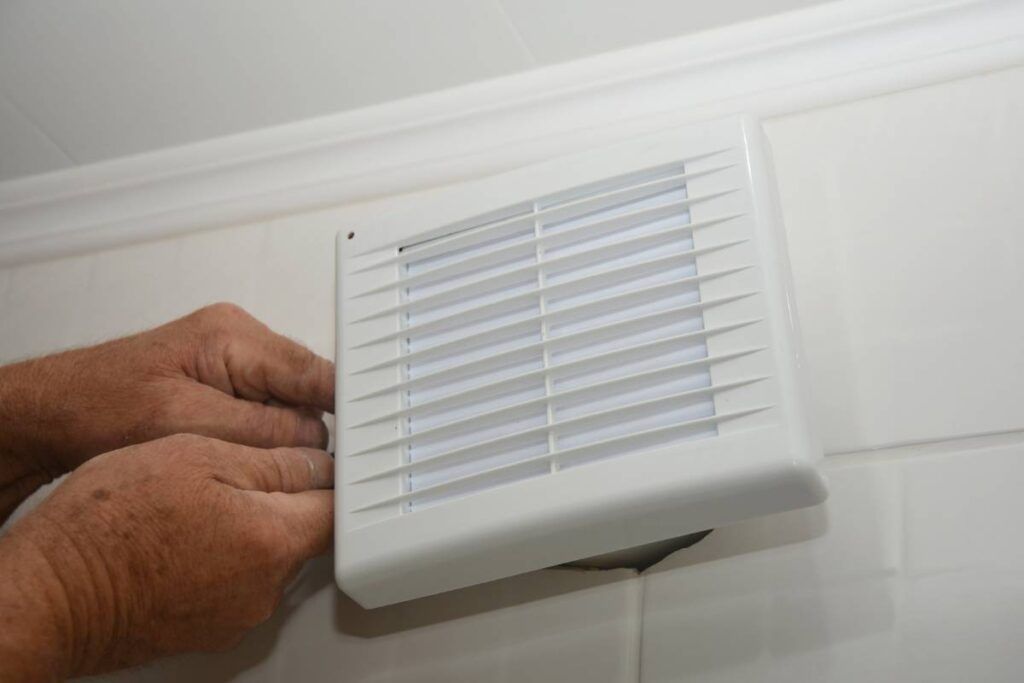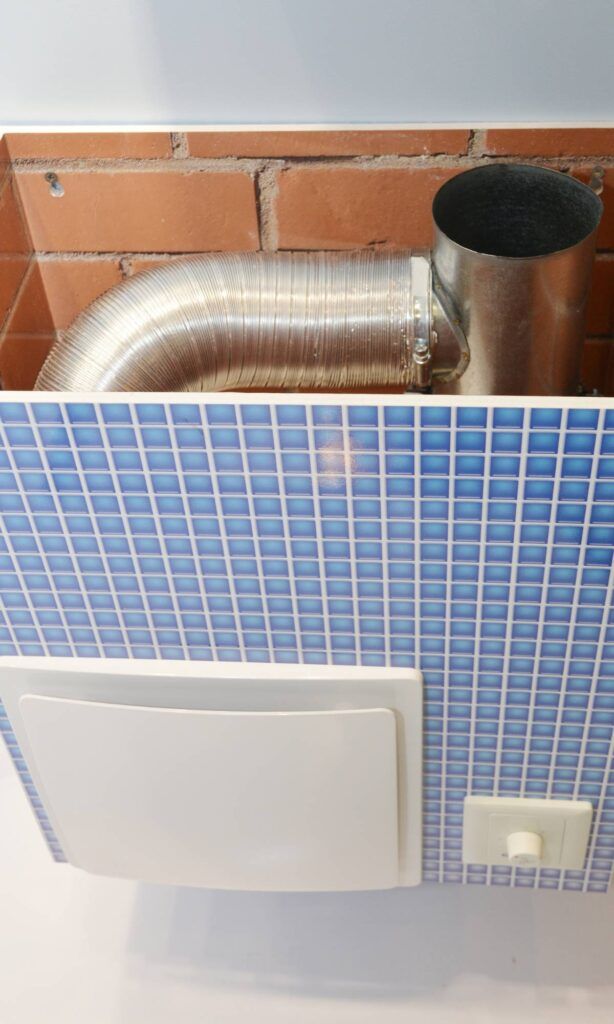In today’s date, bathrooms with exhaust fans are a must. While selecting an exhaust fan, you want to avoid buying the wrong size or type. The right fan size should be able to remove sufficient humidity and bad air from the bathroom without creating annoying noises.
The exhaust fan size for the bathroom depends on the bathroom’s square footage. Your bathroom needs 1 CFM per square footage, and the fan should support 8 air changes per hour. A 50 to 110 CFM fan is common in most bathrooms, but it may change depending on your bathroom size.
Understanding the CFM value is crucial when determining the right exhaust fan size for the bathroom. This guide will share how to determine the right exhaust fan size for different bathroom sizes, factors to consider, and a few tips about installing a fan.

Check out our list of top-handpicked products for all your electrical, appliance, and HVAC system needs to keep your home running smoothly.
This post includes some affiliate links.How to determine the exhaust fan size for the bathroom?
The CFM, or cubic feet per minute, is a unit that determines the exhaust fan size for a bathroom.
The fan’s power is measured in cubic feet per minute.
Generally, the bathrooms will require at least 1 CFM per square footage.
An exhaust fan must be strong enough to fill the bathroom with fresh air every 7.5 minutes or 8 times per hour.
For example, if your bathroom measures 80 square feet, you need a fan with 80 CFM.
Let’s understand the calculation with an example.
Suppose you have a bathroom with 10 feet by 10 feet and an 8 feet ceiling.
So, you need to multiply the bathroom’s length, breadth, and height and then divide the value by 7.5 to get the right CFM fan for the bathroom.
So, 10x10x8 = 800
800/7.5 = 106.67
So, for a bathroom measuring 10 feet by 10 feet and 8 feet in height, you need an exhaust fan with 106.67 CFM.
What is the standard size of the exhaust fan for the bathroom?

Bathroom exhaust vents are generally rated by how much air they can move, measured in cubic feet per minute.
The standard fan sizes are good for most bathrooms, measuring 100 square feet or less.
The rule of thumb is 1 CFM per square footage.
If you have a bathroom measuring 54 square footage, you need an exhaust fan with 54 CFM.
Sometimes, experts recommend installing a slightly oversized fan, for example, a 60 CFM fan for a 54 square feet bathroom.
The minimum fan size for the bathrooms is 50 CFM.
So, if you have bathrooms measuring below 50 square feet, for instance, 42 square feet, you need to install an exhaust fan with 50 CFM.
While selecting the exhaust fan size, you must consider the duct size.
Most 50 CFM exhaust fans will require at least a 4-inch round duct.
The higher the CFM, the bigger the duct size, for instance, a 5 or 6-inch duct.
What factors determine the size of the exhaust fan for the bathrooms?
While selecting the right bathroom size, you need to consider a few factors, like:
- Large bathroom with many occupants
- Tall ceiling
- Bathroom with an enclosed space.
These factors will affect the exhaust fan size; thus, the size will keep changing.
Here is a brief about how these factors can change the exhaust fan size:
Large bathroom with many occupants

The formula to calculate the exhaust fan size is the same as before.
You multiply the length, breadth, and height and divide the value by 7.5.
For bathrooms measuring more than 100 square feet, you have to jump to an oversized exhaust fan, for example, a 100 CFM exhaust fan.
Some larger bathrooms have multiple occupants, like bathtubs, jetted tubs, etc.
In that case, you need to find the CFM needed by each occupant to determine your bathroom’s exact exhaust fan size.
The common occupants include:
- Bathtubs need 50 CFM
- Jetted tubs need 100 CFM
- The shower needs 50 CFM
- The toilet requires 50 CFM
So, if your bathroom has only a shower and a toilet, you need a 100 CFM exhaust fan.
If your bathroom has jetted tubs and bathtubs with toilet and shower, you need a 200 CFM exhaust fan.
Tall ceilings
Generally, most of the bathrooms have 8 feet ceilings.
But some larger bathrooms have a ceiling above 8 feet, like 10 or 11 feet.
In that case, the calculation and fan size will change.
Sometimes, some standard-size bathrooms also have higher ceilings.
An 80 square feet bathroom with 8 feet ceiling, then an 80 CFM fan is fine.
If the ceiling measures 10 feet, you must consider the fan size.
Here is how you calculate:
Multiply the square footage by the ceiling height, i.e., 80 square feet x 10 feet = 800.
Then, divide the number by 60 (minutes in one hour), i.e., 800/60 = 13.33, rounding up to 14.
Now, multiply the number by 8 (8 air changes per hour), i.e., 14×8 = 112
So, for an 80 square feet bathroom with 10 feet ceiling, you need an exhaust fan with 112 CFM.
That is how you determine and calculate the exhaust fan size for your bathroom.
Bathroom with an enclosed space
Some larger bathrooms have enclosed areas for closets, shower spaces, or a toilet.
If your bathroom is one such kind, you must buy an extra small exhaust fan.
Since these areas are enclosed, they will have individual doors.
So, it can be challenging for one exhaust fan to provide adequate air circulation to two different sections.
If your bathroom has an enclosed shower space, you will also need a GFCI (Ground Fault Circuit Interrupter) outlet.
These outlets trip off when moisture enters the outlet.
It is their way of avoiding dangers like short circuits.
Most of the bathroom closets have exhaust fans with lights.
So, you can also get one for your bathroom closet.
Coming to the size of the exhaust fan for the enclosed space, you can select a small exhaust, like a 50 CFM.
An enclosed area will be a small space, so the minimum size of the fan will be fine for such spaces.
Some house owners do not want to add an extra fan for the enclosed spaces in the bathroom.
Besides, it can increase energy bills.
There will be no serious problem if you do not add a second fan.
In that case, you need to keep the door of the enclosed space partially open for adequate air circulation and to let bad air escape.
It will make a primary vent fan.
How should you deal with the fan’s noise rating?

Once you have decided on the right fan size for your bathroom, you need to consider the sound rating.
The sound and the fan size have a one-to-one relationship.
An oversized exhaust fan will create very loud and weird noises.
Besides, it also puts negative pressure on the bathroom.
To understand the right sound rating, you need to know the sone rating to measure the loudness.
A quiet fan is a valuable investment to keep the bathroom peaceful and calm.
Exhaust fans with lower sone numbers will be quieter, and higher numbers will have loud noises.
A sone rating of 1 is the quietest of all.
Here are a few sone ratings to help you find a suitable fan for your bathroom:
- 1 sone rating is equal to a refrigerator’s humming and whispering, which is around 29 decibels.
- 2 sone rating is similar to the ambient sound in the library, around 38 decibels.
- 3 sone rating is similar to the sound of a low conversation with 44 decibels.
- 4 sone rating will equal the sound of a television, measuring 48 decibels.
- 5 sone rating equals the sound of moderate rainfall, around 51 decibels.
These sound ratings can help you find the amount of noise a fan can make.
What happens if I get an undersized or oversized fan?
Sometimes, house owners get an undersized exhaust fan so that the bathrooms can have quiet noises.
When you get a powerful exhaust fan that suits your bathroom, it does not mean it will create loud noises.
The amount of noise an exhaust fan makes while operating is rated in sones.
Most bathroom fans will have noise ratings between 0.3 to 4, 4 being the loudest.
Suppose you have chosen an undersized fan because it has a rating below 1.
In that case, the fan won’t be able to ventilate your bathroom properly.
As a result, your bathroom will have humidity and bad air despite having an exhaust fan.
So, always choose the exact one.
Similarly, an oversized fan is also not good and puts negative pressure on your bathroom.
Too much oversized will create loud noises.
It can be slightly oversized. For example, to remain safe, you can get a 60 CFM fan for a bathroom measuring 54 square feet.
What if I do not replace the exhaust fan?
Some house owners do not want to replace their undersized exhaust fans.
If you do not have to change it, there are a few other options to deal with it.
You can install a fan timer mounted in the place of the switch.
It will let your fan run for a limited time, like, 5-10-15-30 minutes.
Next, you can install a humidity-sensing fan control.
A switch will turn on automatically when the humidity gets too high and shut off when the humidity level reduces.
You can keep your bathroom door open partially, install a freshener, or have an open window high up.
Types of exhaust fan for the bathroom
There are two types of fans, exhaust fans, and ventilation fans.
The exhaust fan helps release the bad air out, and a ventilation fan brings fresh air.
If you want to have an exhaust fan, you can choose from the following type:
- Ceiling mount fans: These exhaust fans are the popular ones for the bathroom, and it works by connecting to the exhaust duct above the bathroom.
- Wall mount: These fans are used when your bathroom cannot have ceiling mount fans. These fans will vent directly outside without any exhaust ductwork.
- Inline fans: These fans are installed in a remote space and tap into the ductwork of the attic. A grille in the bathroom ceiling will connect to the system.
- Window mount: You can use this fan by inserting it just the window-mounted air conditioners.
How to install a bathroom exhaust fan?
A window fan that works when you plug it inside the wall receptacle will not require installation.
But you must install a GFCI outlet.
Installing a fan is quite challenging as it requires cutting a hole in the wall and then sealing it after everything is finished.
You may deal with some electrical wiring if there is no plug.
The ceiling mount fans are more complicated to install.
Here are the steps to install a bathroom exhaust fan in the ceiling:
Location
You can install the exhaust fan in the ceiling if you have one bathroom with no enclosed areas.
If your bathroom includes a toilet and shower, place the fan between the toilet and the tub or shower.
Plan the duct route

The duct has to be straight and short to pass through the attic to the roof or the sidewall.
If your house has no attic, the duct should pass between the ceiling joists and involve drywall removal.
Cut holes
Find two locations.
One location will be to cut a hole for the fan in the ceiling.
Another location will be to cut a hole for the exhaust vent in the roof or sidewall.
If you have a separate water closet, find a small exhaust separately.
Install the fan and the exhaust vent.
Once you have cut holes, you must install the fan and the vent.
Secure the fans to the ceiling joists with braces.
The exhaust vent will be attached to the roof deck or the sides with appropriate flashing.
Connect the duct

A flexible duct is suitable for the bathroom exhaust fan.
Clamp it to the fan and the exhaust vent.
Hook up the fan to power.
Wire the fan to the wall switch.
Connect it to your house’s electrical system by tying it to the outside circuit.
Otherwise, you can also install a new one for the fan with a separate circuit breaker.
Door clearance
While installing the fan, ensure the bathroom door contains about ¾ inch of clearance from the floor.
It will let the air enter to replace the sucked-out air and put less stress on the fan.
Fan options
Four types of fans are ceiling, window, inline, and wall.
But these fans also come in various types, like only the fan, fans with light, etc.
So, if you want to increase the aesthetic of your bathroom, here are some options:
- Fan only – For a small retrofitting bathroom, you can use a 50 to 70 CFM fan costing around $15 to $50.
- Fan and light combo – This fan is good for small bathrooms or water closets. The cost will be around $30 to $150.
- Deluxe combo – The fan includes various features – fan, light, heater, nightlight, timer, and a humidistat. The humidistat will turn on the fan automatically when the air moisture increases. The cost will be $150 to $600.
Final thoughts

There is no exact fan size.
The right exhaust fan size depends on the square footage of your bathroom.
As a rule of thumb, a bathroom will need 1 CFM per square foot.
The exhaust fans should be strong enough to vent the bathroom every 7.5 minutes or receive 8 air changes per hour.
For example, an 80 square feet bathroom needs an 80 CFM exhaust fan, provided the height remains 8 feet.
The exhaust fan size will change based on factors like the height, the bathroom with multiple other occupants, and an enclosed area.
If the height is more than 8 feet, the size will increase.
For larger bathrooms with multiple occupants, add up the required CFM for each occupant and then calculate the CFM of the bathroom.
You need an extra fan if your bathroom has enclosed areas like a closet, toilet, or shower.
Otherwise, keep the door partially open to let it work as a vent.
FAQs
Will the CFM get affected by the duct size?
The quality and size of the duct can affect the bathroom’s CFM.
For a 3-inch duct, if you buy an exhaust with 130 CFM with a 6-inch duct, the appliance will not work well.
Will the exhaust fans be very powerful?
Yes, they will be powerful, so you must choose an exhaust fan whose size suits the bathroom’s size.
Oversized fans will create disturbing noises, and undersized fans will not serve the purpose.


